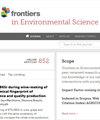The impact of China’s digital economy industry development and its structural indicators on carbon emission intensity
IF 3.3
3区 环境科学与生态学
Q2 ENVIRONMENTAL SCIENCES
引用次数: 0
Abstract
IntroductionThe development of the digital economy has a profound impact on industrial economics. The article starts from the perspective of industrial organization theory. The thesis aims to analyze the industrial development of the digital economy and its three structural variables: digital manufacturing industry, digital service industry, and the development of industrial digitization on carbon emission intensity.MethodBased on the data of Input-output Tables with extended tables of 30 provinces, this paper analyzes the industrial development of digital economy and its three structural variables: digital manufacturing industry, digital service industry, and the development of industrial digitization on carbon emission intensity.Results and discussionThe empirical results show that: 1) at the national level, the development of China’s digital economy industries has a suppressive effect on carbon emission intensity; 2) in terms of spatial effects, the development of digital economy has significant carbon spillover effects, but digital industrialization and industrial digitization present different spatial effect results; 3) from the analysis of regional heterogeneity, in the northeast, central and western regions, the direction of influence of digital industrialization and industrial digitalization on carbon emission intensity is consistent; in the eastern region, the development of digital industrial service sector and industrial digitalization has a suppressive effect on carbon emission intensity, while digital industrial manufacturing sector presents a pro-increasing effect; 4) Non-linear relationship analysis shows that the development of the digital industrial manufacturing sector has a “promoting and then inhibiting” effect on carbon emission intensity. Overall, the impact of digital industry development on carbon intensity exhibits a “promoting increase, then suppressing, then promoting increase” trend. In conclusion, the findings suggest that China’s digital economy industry has entered the low-carbon development stage.中国数字经济产业发展及其结构指标对碳排放强度的影响
引言 数字经济的发展对产业经济学产生了深远影响。本文从产业组织理论的视角出发。方法本文基于30个省份的投入产出表及扩展表数据,分析了数字经济产业发展及其三个结构变量:数字制造业、数字服务业和产业数字化发展对碳排放强度的影响。结果与讨论实证结果表明:1)在全国层面,中国数字经济产业发展对碳排放强度具有抑制作用:1)从全国层面看,我国数字经济产业发展对碳排放强度具有抑制作用;2)从空间效应看,数字经济发展具有显著的碳溢出效应,但数字产业化和工业数字化呈现不同的空间效应结果;3)从区域异质性分析,在东北、中西部地区,数字产业化和工业数字化对碳排放强度的影响方向一致;4)非线性关系分析表明,数字工业制造业的发展对碳排放强度具有 "先促进后抑制 "的作用。总体而言,数字产业发展对碳排放强度的影响呈现出 "先促增,后抑制,再促增 "的趋势。总之,研究结果表明,中国数字经济产业已进入低碳发展阶段。
本文章由计算机程序翻译,如有差异,请以英文原文为准。
求助全文
约1分钟内获得全文
求助全文
来源期刊

Frontiers in Environmental Science
Environmental Science-General Environmental Science
CiteScore
4.50
自引率
8.70%
发文量
2276
审稿时长
12 weeks
期刊介绍:
Our natural world is experiencing a state of rapid change unprecedented in the presence of humans. The changes affect virtually all physical, chemical and biological systems on Earth. The interaction of these systems leads to tipping points, feedbacks and amplification of effects. In virtually all cases, the causes of environmental change can be traced to human activity through either direct interventions as a consequence of pollution, or through global warming from greenhouse case emissions. Well-formulated and internationally-relevant policies to mitigate the change, or adapt to the consequences, that will ensure our ability to thrive in the coming decades are badly needed. Without proper understanding of the processes involved, and deep understanding of the likely impacts of bad decisions or inaction, the security of food, water and energy is a risk. Left unchecked shortages of these basic commodities will lead to migration, global geopolitical tension and conflict. This represents the major challenge of our time. We are the first generation to appreciate the problem and we will be judged in future by our ability to determine and take the action necessary. Appropriate knowledge of the condition of our natural world, appreciation of the changes occurring, and predictions of how the future will develop are requisite to the definition and implementation of solutions.
Frontiers in Environmental Science publishes research at the cutting edge of knowledge of our natural world and its various intersections with society. It bridges between the identification and measurement of change, comprehension of the processes responsible, and the measures needed to reduce their impact. Its aim is to assist the formulation of policies, by offering sound scientific evidence on environmental science, that will lead to a more inhabitable and sustainable world for the generations to come.
 求助内容:
求助内容: 应助结果提醒方式:
应助结果提醒方式:


